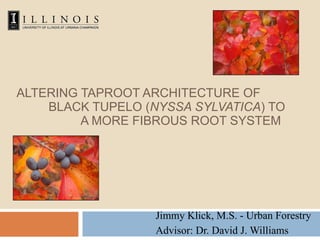ALTERING TAPROOT ARCHITECTURE OF BLACK TUPELO (NYSSA SYLVATICA) TO A MORE FIBROUS ROOT SYSTEM
- 1. ALTERING TAPROOT ARCHITECTURE OF BLACK TUPELO ( NYSSA SYLVATICA ) TO A MORE FIBROUS ROOT SYSTEM Jimmy Klick, M.S. - Urban Forestry Advisor: Dr. David J. Williams
- 3. Research Introduction Air-root pruning Small Containers
- 4. Research Introduction Air-root pruning Small Containers Medium Containers
- 5. Research Introduction Air-root pruning Small Containers Medium Containers Auxin (K-IBA) 0 mg/L 1875 mg/L 3750 mg/L 7500 mg/L
- 7. Root Rating Density Mass Coarse roots Circling roots Dead roots 1 3
- 8. Ordinal Logistic Model Root Rating Why? Ordinal values No transformation Determines likelihood of something occurring How does it work? Odds Ratio Determines how different one treatment is from another Confidence intervals
- 9. Results: Root Rating Small Containers cd ab de de bc a bc ef f
- 10. Root Structure (Visual observations) Plant Band Container Fabric Container
- 11. Results: Root Rating Medium Containers b b a a
- 12. Results: Auxin Root Rating a
- 13. Survival Rate 0 mg/L: 40% 1875 mg/L: 75% * 3750 mg/L: 65% * 7500 mg/L: 70% * * significant difference (P = 0.025)
- 14. Conclusions Small air-root pruning containers Black fabric and Plant Band Medium air-root pruning containers Black fabric and green mesh Auxin dips Transplant survivability
- 15. Future Studies Media Transplant Auxin Ordinal Logistics Model
- 16. Acknowledgements Advisor: Dr. David J. Williams Committee: Dr. Gary J. Kling and Dr. Jeffrey O. Dawson Joseph Castro and Massimo Bionaz for help with statistical analysis IR-4 Program for funding my research assistantship High Caliper Growing Systems, Lacebark Inc., Nursery Supplies Inc. for providing containers
Editor's Notes
- #3: small containers from left to right: standard (2”x4”), fine mesh, coarse mesh, accelerator, black fabric (smart pot), zipset plant bands (many holes, several holes and no holes), rootmaker medium containers from left to right: black fabric (2”x4”), white fabric, green mesh and standard 1 gallon
- #7: This talk only has time to discuss the later two variables.
- #8: Roots rated based on different criteria. 1=least dense, coarse roots, circling roots and dead roots; 4=most dense, fine roots, no circling roots and no dead roots.
- #9: Root Rating Ordinal Logistic Model Why? No transformation In traditional statistical analysis residuals could not be normalized Determines likelihood of something occurring, aside from determining differences (ANOVA) Ordinal values are categorical where there is a logical ordering to the categories. 1=worst root 4=best root sytem more appropriate for production method that is not measured ordinal values evaluated by traditional statistical methods in horticultural research usually this is not done this is a better way How does it work? Odds Ratio Determines how different one treatment is from another In this study, it determined how much likelier root systems were rated greater than 3 (thus 4). Confidence intervals given determine significance Significant difference achieved when 1.0 does not fall between confidence intervals
- #10: 1% probability roots will be rated 1 when grown in standard containers, 9% probability roots will be rated 2 when grown in standard containers, 80% probability roots will be rated 3 when grown in standard containers and 10% probability roots will be rated 4 when grown in standard containers. Extreme ends Coarse mesh containers: 50% probability roots will be rated 1 when grown in coarse mesh containers, 40% probability roots will be rated 2, 10% probability roots will be rated 3 Plant band containers with 12 holes: 15% probability roots will be rated 3 when grown in plant band containers with 12 holes and 85% probability roots will be rated 4
- #11: Root structure of plants produced in the two best containers -plant band container plants had primarily vertical roots -slightly more root branching occurred near holes (red circles), b/c roots were air root pruned -plants grown in fabric containers had vertical and lateral roots -advantages over plant band -higher surface area -may have better nutrient and water uptake -may have better stability in the field
- #12: Green mesh and black fabric have a 50% probability roots will be rated 4, whereas standard and white fabric containers have a 10% probability roots will be rated 4. Root systems in standard containers were downgraded due to high frequency of circling roots. White fabric containers had problems of remaining water logged, thus producing an unfavorable environment for root growth.
- #13: No difference, however, trend shows that increasing concentrations resulted in higher probabilities roots will be rated 4.
- #14: Survivability was significantly greater in plants that were dipped in K-IBA. Note: Higher concentrations of Auxin did not adversely affect plant survival like in most studies.
- #15: small: black fabric and plant bands produced most fibrous root system medium: black fabric and green mesh produced most fibrous root system auxin: auxin promoted survivability
- #16: ideal media for air-root pruning containers what happens next in terms of performance, using air-root pruning containers in combination with auxin 3 options transplanted to larger containers transplanted to the nursery field transplanted directly to the landscape how they perform after transplanting survivability of transplanted plants with better root system better survivability when transplanted survival in the landscape Ordinal logistics model is rarely used in nursery production research recommended use for studies with ordinal values















